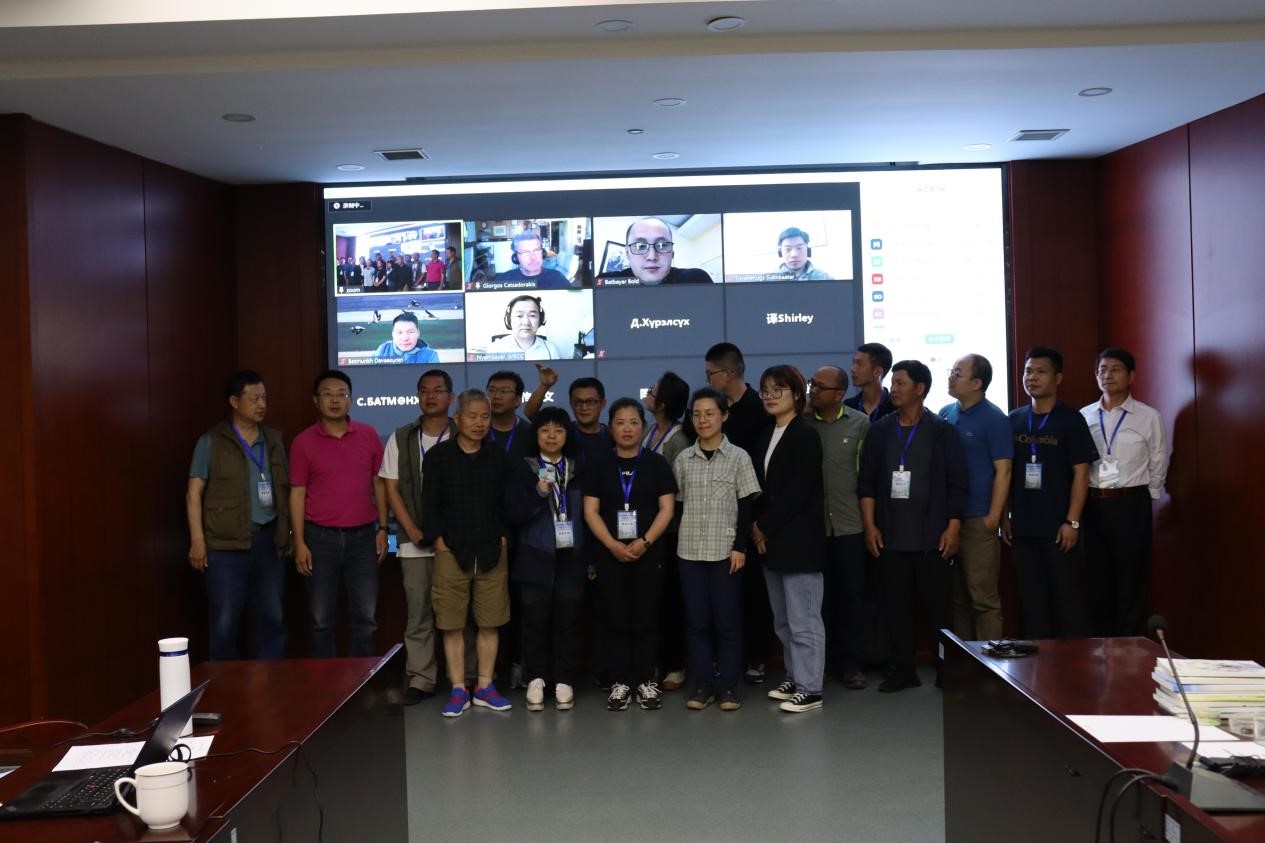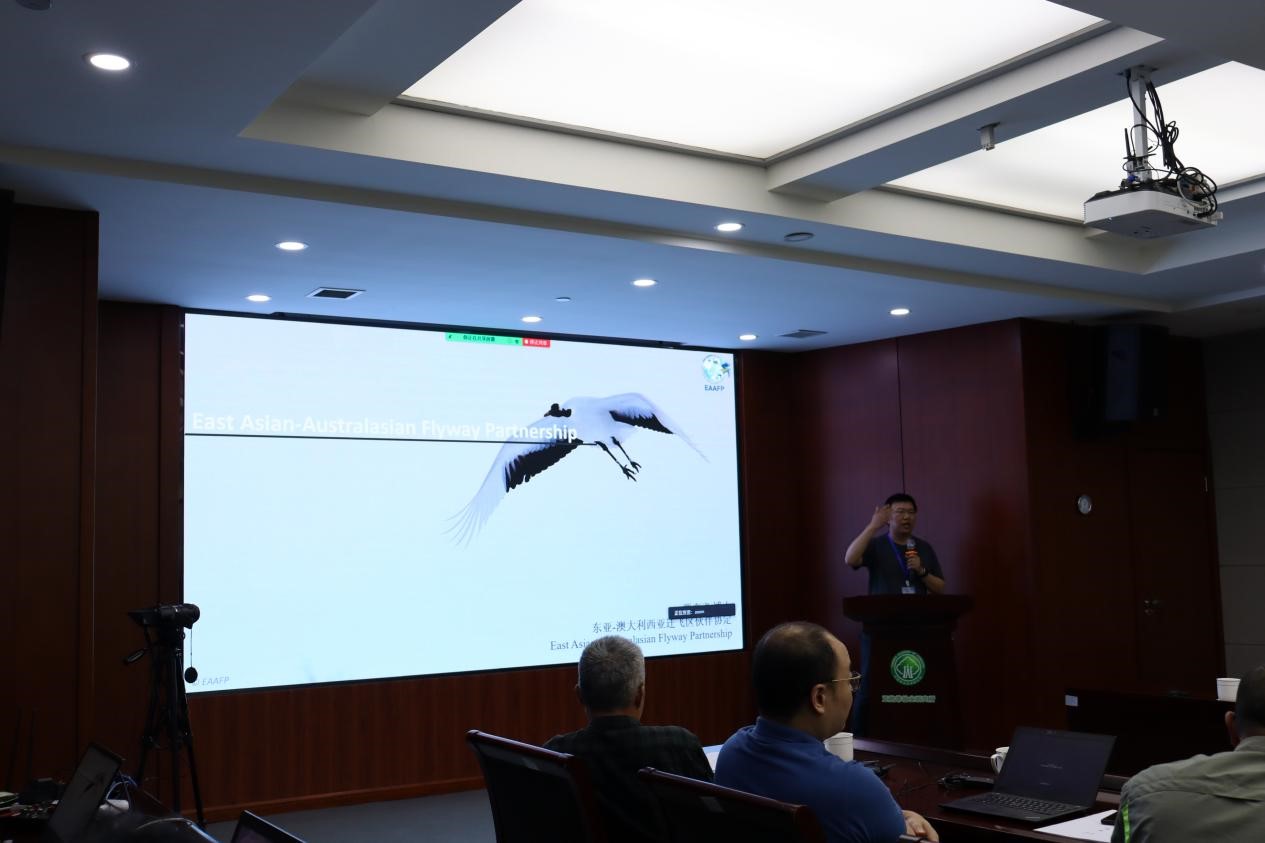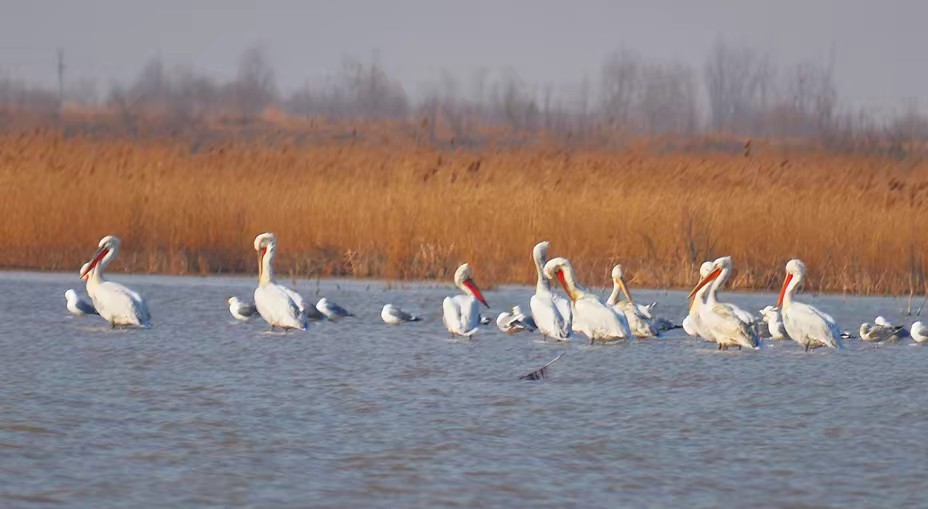From May 12-14, the Research Institute of Subtropical Forestry (RISF) of the Chinese Academy of Forestry (CAF) and the Society of Entrepreneurs & Ecology (SEE) in Beijing co-hosted The First International Symposium on the Conservation of East Asian Population of the Dalmatian Pelican. The theme of the symposium was “connecting habitats along the Dalmatian Pelican’s flyway”. This was also the first general meeting of the EAAFP Pelican Task Force since its first meeting that was held in Khovd, Mongolia in July 2019. Due to the impact of the coronavirus epidemic, the seminar adopted a combination of online and offline formats. A total of 85 representatives related to the conservation of Dalmatian Pelican participated, including 55 domestic experts attending the meeting on site and 30 foreign experts participating online. Participants included scientific researchers, nature reserve managers, domestic and international ecological, environmental and birdwatching organizations, and other conservationists.

Group Photo of the 1st Dalmatian Pelican Symposium © EAAFP Science Unit
The opening ceremony was presided over by WU Tonggui, Director/Researcher of Research Institute of Subtropical Forestry, Chinese Academy of Forestry. WANG Yangdong, Secretary of the Party Committee of the RISF, introduced the general situation of RISF and its research and conservation work in birds, and raised high expectations for the seminar. Doug WATKINS, Chief Executive of the EAAFP, ZHANG Li, Secretary General of Beijing Entrepreneur SEE, and DING Le Ping, Deputy Secretary General of the SEE Jiangnan Project Center, delivered speeches respectively.
Dr. Giorgos CATSADORAKIS, Chair of the IUCN Pelican Specialist Group, shared the status of the world population trends and conservation success stories for Dalmatian Pelicans in southern Europe; Dr. Nyambayar BATBAYAR, Chair of the EAAFP Dalmatian Pelican Task Force, has compiled the population status, bird banding study and migration of the breeding population of Dalmatian Pelican in Mongolia; Simba Chan from the Wild Bird Society of Japan introduced the population and distribution of Dalmatian Pelicans in Southeast Asia and other places; Dr. JIAO Shengwu, Coordinator of EAAFP DP TF, presented the current status of the migrating and wintering populations, distribution and threats of the pelican in China; Mr. JIANG Zeyin, Senior Project Manager of Beijing SEE, introduced the development of the SEE’s Let Birds Fly programme; Dr. JIA Yifei representing Science Unit of EAAFP presented the status and establishment of the EAAFP and the Dalmatian Pelican Task Force.

Mr. Doug Watkins, Chief Executive of EAAFP, giving congratulatory remarks. © EAAFP Science Unit
In view of the lack of research and little conservation attention, in order to better carry out research and conservation of the Dalmatian Pelican, the seminar also invited Dr. FAN Zhongyong from Zhejiang Museum of Natural History to share their work conducted on the Chinese Crested Tern, Dr. JIA Yifei from CEAAF of Beijing Forestry University to introduce the coastal wetlands and conservation of the Spoon-billed Sandpiper in China, Ms. LIU Jieyun from the World Wide Fund for Nature (WWF) presented WWF’s bird conservation projects about bird conservation on the flyway, and Ms. FANG Lu from Qingdao Marine Ecology Research Association introduced the problems of China’s offshore fisheries issues and their impact on the survival of the Dalmatian Pelican. Afterwards, bird researchers and conservationists from Wenzhou, Zhejiang Province, Xiamen, Fujian Province, Cangzhou, Hebei Province and Xi’an, Shaanxi Province shared their views on the situation of the Dalmatian Pelican in each location. Participants discussed the status of the Dalmatian Pelican Conservation Network in China, and concluded with a conservation initiative for the Dalmatian Pelican.
In recent years, the Zhejiang Provincial Forestry Bureau has been actively supporting the RISF to carry out work on migration and protection and propaganda of Dalmatian Pelican. The 14th Five-Year Plan for the Rescue and Protection of Rare and Endangered Wildlife and Plants in Zhejiang Province also includes the Dalmatian Pelican in its list. The bureau will continue to carry out investigation, monitoring and protection of the Dalmatian Pelican. In this meeting, the SEE Jiangnan Project Center intended to make the Dalmatian Pelican the second targeted waterbird species of protection in Zhejiang Province after the Chinese Crested Tern. The RISF will also continue to promote the work of the “Chinese Dalmatian Pelican Conservation Network” to attract more organizations and individuals to contribute to the EAAFP Dalmatian Pelican Working Group.

Dr. JIA Yifei introducing EAAFP © EAAFP Science Unit
Chinese version
“首届卷羽鹈鹕东亚种群保护国际研讨会”
在中国林科院亚林所召开
5月12-14日,中国林业科学院亚热带林业研究所(下简称亚林所)与北京市企业家环保基金会(SEE)共同主办了“首届卷羽鹈鹕东亚种群保护国际研讨会”。本次研讨会的主题是:连通卷羽鹈鹕迁徙路线上的栖息地。这也是东亚-澳大利西亚迁飞区鹈鹕工作组自2019年成立大会后,第一次大会。由于受新冠疫情的影响,本次研讨会采用线上和线下结合的方式,共有包括与卷羽鹈鹕保护相关的85名代表参加,其中现场出席会议的国内专家55名,线上参加的外国专家30名。与会人员包括科研人员、自然保护地管理人员、国内外生态、环保以及观鸟组织保护人员等。
开幕式由亚林所吴统贵处长/研究员主持,中国林科院亚热带林业研究所党委书记汪阳东介绍了中国林科院亚林所的概况以及在鸟类方面开展的研究保护工作和取得的成就,并对研讨会提出了殷切的期望。东亚-澳大利西亚迁飞区伙伴协定(EAAFP)首席执行官Doug Watkins、北京市企业家环保基金会秘书长张立、阿拉善SEE江南项目中心副秘书长丁乐平分别致辞。
会议特邀世界自然保护联盟(IUCN)鹈鹕专家组主席Giorgos Catsadorakis博士分享了世界上卷羽鹈鹕种群趋势和保护发展的现状;蒙古国野生动物研究和保护中心,鹈鹕工作组主席Nyambayar Batbayar博士汇总了蒙古国繁殖卷羽鹈鹕的种群数量现状、环志以及迁徙情况;亚林所/卷羽鹈鹕国际协调员焦盛武博士则展示了中国卷羽鹈鹕迁徙和越冬的种群数量、分布以及威胁等现状;日本野鸟会的Simba Chan博士介绍了卷羽鹈鹕在东南亚以及其它地方的数量和分布情况; 北京市企业家环保基金会高级项目经理蒋泽银先生介绍了阿拉善任鸟飞项目的开展情况;东亚-澳大利西亚迁飞区伙伴协定秘书处科学部贾亦飞博士介绍了EAAFP及卷羽鹈鹕工作组情况及成立过程。
鉴于研究缺失和保护关注少,为了更好地开展卷羽鹈鹕研究和保护,本次研讨会还邀请了浙江省自然博物院范忠勇博士分享在中华风头燕鸥上开展的研究和保护、北京林业大学东亚-澳大利西亚候鸟迁徙研究中心贾亦飞博士介绍中国滨海湿地及勺嘴鹬的保护、世界自然基金会(WWF)刘洁芸女生展示WWF在迁飞路线上的鸟类保护项目、青岛市海洋生态研究会房璐女士介绍中国近海渔业问题及对卷羽鹈鹕生存影响。随后,来自浙江温州、福建厦门、河北沧州、陕西西安等地的鸟类研究和保护者针对各个地方卷羽鹈鹕的情况进行了交流。与会人员利用晚上时间讨论了中国卷羽鹈鹕保护网络的情况,最后会议提出了卷羽鹈鹕的保护倡议。
近年来,浙江省林业局积极支持亚林所开展了卷羽鹈鹕迁徙、栖息研究及保护、宣教等方面的工作。浙江省珍稀濒危野生动植物抢救保护行动“十四五”规划也将卷羽鹈鹕列入到名单中,将继续开展卷羽鹈鹕调查监测和保护工作。借助此次会议,阿拉善江南中心意欲将卷羽鹈鹕打造成为继中华风头燕鸥后的第二个浙江省濒危水鸟保护的对象。亚林所也将继续推进“中国卷羽鹈鹕保护网络”的工作,吸引更多国内的组织和个人为EAAFP卷羽鹈鹕工作组贡献力量。





